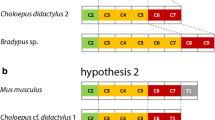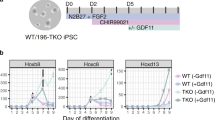Abstract
Ribs on the seventh cervical vertebra, so-called cervical ribs, imply a change of the highly conserved number of cervical vertebrae in mammals from seven to six. Cervical ribs are rare in the general population, but they are common in deceased fetuses and infants. There is strong, often prenatal, selection against individuals with cervical ribs and as such, cervical ribs can be seen as marker of a disturbed early embryogenesis which may include congenital abnormalities of all organ systems. The almost unavoidable association with many different abnormalities appears to be due to the high global interactivity during the embryonic patterning of the cervical vertebrae. This strong interactivity can also explain the large heterogeneity of genetic and environmental causes of cervical ribs. In other mammals cervical ribs are also associated with abnormalities. Exceptionally the slow sloths and manatees can tolerate some of these normally deleterious side-effects, which has apparently allowed them to evolve an abnormal cervical vertebral number. In long-necked reptiles and birds, there is no constraint on changes of the number of cervical vertebrae.
Access this chapter
Tax calculation will be finalised at checkout
Purchases are for personal use only
Similar content being viewed by others
References
McNally E, Sandin B, Wilkins RA. The ossification of the costal element of the seventh cervical vertebra with particular reference to cervical ribs. J Anat. 1990;170:125–9.
Narita Y, Kuratani S. Evolution of the vertebral formulae in mammals: a perspective on developmental constraints. J Exp Zool B Mol Dev Evol. 2005;304(2):91–106.
Varela-Lasheras I, Bakker AJ, van der Mije SD, Metz JA, van Alphen J, Galis F. Breaking evolutionary and pleiotropic constraints in mammals: on sloths, manatees and homeotic mutations. EvoDevo. 2011;2(1):11.
ten Broek CM, Bakker AJ, Varela-Lasheras I, Bugiani M, Van Dongen S, Galis F. Evo-devo of the human vertebral column: on homeotic transformations, pathologies and prenatal selection. Evol Biol. 2012;39(4):456–71.
Galis F, Van Dooren TJM, Feuth JD, Metz JAJ, Witkam A, Ruinard S, et al. Extreme selection in humans against homeotic transformations of cervical vertebrae. Evolution. 2006;60(12):2643–54.
Schut PC, Cohen-Overbeek TE, Galis F, Ten Broek CMA, Steegers EA, Eggink AJ. Adverse fetal and neonatal outcome and an abnormal vertebral pattern: a systematic review. Obstet Gynecol Surv. 2016;71(12):741–50.
Menarguez Carretero AL. M. CM. A radiologic study and the morphologic types of cervical ribs in the female. Enferm Torax. 1967;16:285–308.
Kerley P. The normal spine and pelvis. In: Shanks S, Kerley P, editors. A textbook of X-ray diagnosis by British authors. 6 bones, joints and soft tissues. London: HK Lewis; 1971.
Todd TW. The relations of the thoracic operculum considered in reference to the anatomy of cervical ribs of surgical importance. J Anat Physiol. 1911;45(Pt 3):293.
Chernoff N, Rogers JM. Supernumerary ribs in developmental toxicity bioassays and in human populations: incidence and biological significance. J Toxicol Env Heal B. 2004;7(6):437–49.
Merks JH, Smets AM, Van Rijn RR, Kobes J, Caron HN, Maas M, et al. Prevalence of rib anomalies in normal Caucasian children and childhood cancer patients. Eur J Med Genet. 2005;48(2):113–29.
Schut PC, Brosens E, Van Dooren TJM, Galis F, Ten Broek CMA, Steegers EA, et al. Exploring copy number variants in decreased fetuses and neonates with abnormal vertebral patterns and cervical ribs. Birth Defects Res 2020;144:105027.
Etter L. Osseous abnormalities of the thoracic cage seen in forty thousand consecutive chest photoroentgenograms. Am J Roentgenol. 1944;81:359–63.
Kühne K. Die Vererbung der Variationen der menschlichen Wirbelsäule. Z Morphol Anthropol. 1932;H.1/2:1–221.
Fischel A. Untersuchungen über die Wirbelsäule und den Brustkorb des Menschen. Anatomische Hefte. 1906;31(3):462–588.
Oostra RJ, Hennekam RC, de Rooij L, Moorman AF. Malformations of the axial skeleton in museum Vrolik I: homeotic transformations and numerical anomalies. Am J Med Genet A. 2005;134(3):268–81.
Schumacher R, Mai A, Gutjahr P. Association of rib anomalies and malignancy in childhood. Eur J Pediatr. 1992;151(6):432–4.
Galis F, Metz JA. Anti-cancer selection as a source of developmental and evolutionary constraints. BioEssays. 2003;25(11):1035–9.
Galis F. Why do almost all mammals have seven cervical vertebrae? Developmental constraints, Hox genes, and cancer. J Exp Zool. 1999;285(1):19–26.
Redenbach DM, Nelems B. A comparative study of structures comprising the thoracic outlet in 250 human cadavers and 72 surgical cases of thoracic outlet syndrome. Eur J Cardiothorac Surg. 1998;13:353–60.
Roos DB. Congenital anomalies associated with thoracic outlet syndrome. Anatomy, symptoms, diagnosis, and treatment. Am J Surg. 1976;132:771–8.
Brent AE, Braun T, Tabin CJ. Genetic analysis of interactions between the somitic muscle, cartilage and tendon cell lineages during mouse development. Development. 2005;132:515–38.
Bradley OC. On a case of rudimentary first thoracic rib in a horse. J Anat Physiol. 1901;36:54–62.
Mallo M, Wellik DM, Deschamps J. Hox genes and regional patterning of the vertebrate body plan. Dev Biol. 2010;344(1):7–15.
Vermot J, Pourquié O. Retinoic acid coordinates somitogenesis and left-right patterning in vertebrate embryos. Nature. 2005;435:215–20.
Diez del Corral R, Olivera-Martinez I, Goriely A, Gale E, Maden M, Storey K. Opposing FGF and retinoid pathways control ventral neural pattern, neuronal differentiation, and segmentation during body axis extension. Neuron. 2003;40(1):65–79.
Yang X, Dormann D, Muensterberg AE, Weijer CJ. Cell movement patterns during gastrulation in the chick are controlled by positive and negative chemotaxis mediated by FGF4 and FGF8. Dev Cell. 2002;3:425–37.
Galis F, Metz JA. Testing the vulnerability of the phylotypic stage: on modularity and evolutionary conservation. J Exp Zool. 2001 Aug 15;291(2):195–204.
Krebs LT, Iwai N, Nonaka S, Welsh IC, Lan Y, Jiang R, et al. Notch signaling regulates left–right asymmetry determination by inducing nodal expression. Genes Dev. 2003;17(10):1207–12.
Keeling JW, Kjaer I. Cervical ribs: useful marker of monosomy X in fetal hydrops. Pediatr Dev Pathol. 1999;2(2):119–23.
Schut PC, Ten Broek CMA, Cohen-Overbeek TE, Bugiani M, Steegers EAP, Eggink AJ, et al. Increased prevalence of abnormal vertebral patterning in fetuses and neonates with trisomy 21. J Matern Fetal Neonatal Med. 2018;32:1–7.
Furtado LV, Thaker HM, Erickson LK, Shirts BH, Opitz JM. Cervical ribs are more prevalent in stillborn fetuses than in live-born infants and are strongly associated with fetal aneuploidy. Pediatr Dev Pathol. 2011;14(6):431–7.
Wéry N, Narotsky MG, Pacico N, Kavlock RJ, Picard JJ, Gofflot F. Defects in cervical vertebrae in boric acid-exposed rat embryos are associated with anterior shifts of Hox gene expression domains. Birth Defects Res A Clin Mol Teratol. 2003;67(1):59–67.
Rengasamy P, Padmanabhan RR. Experimental studies on cervical and lumbar ribs in mouse embryos. Congenit Anom (Kyoto). 2004;44:156–71.
Connely LE, Rogers JM. Methanol causes posteriorization of cervical vertebrae in mice. Teratology. 1197;55:138–44.
Brocal J, De Decker S, José-López R, Manzanilla EG, Penderis J, Stalin C, et al. C7 vertebra homeotic transformation in domestic dogs–are pug dogs breaking mammalian evolutionary constraints? J Anat. 2018;233(2):255–65.
Van der Geer AE. High incidence of cervical ribs indicates vulnerable condition in late Pleistocene woolly rhinoceroses. PeerJ. 2017;5:e3684.
Palma A, Carini F. Variazioni dell’apofisi trasversa della settima vertebra cervicale: studio anatomo-radiologico su una popolazione “segregata”. Arch Ital Anat Embriol. 1990;95:11–6.
Galis F, Carrier DR, van Alphen J, van der Mije SD, Van Dooren TJM, Metz JAJ, et al. Fast running restricts evolutionary change of the vertebral column in mammals. Proc Natl Acad Sci. 2014;111(31):11401–6.
Damur-Djuric N, Steffen F, Hässig M, Morgan J, Flückiger M. Lumbosacral transitional vertebrae in dogs: classification, prevalence, and association with sacroiliac morphology. Vet Radiol Ultrasound. 2006;47(1):32–8.
Slijper EJ. Die Cetaceen: Vergleichend-Anatomisch und Systematisch. The Netherlands: Martinus Nijhoff, ‘s Gravenhage; 1962.
Nagy J, Victor E, Cropper J. Why don’t all whales have cancer? A novel hypothesis resolving Peto’s paradox. J Integr Comp Biol. 2007;47:317–28.
Woolfenden GE. Postcranial osteology of the waterfowl. Bull Florida State Museum Biol Sci. 1961;6:1–129.
Hofstetter R, Gasc J. Vertebrae and ribs of modern reptiles. In: Gans C, AdA B, Parsons TS, editors. Biology of the reptilia, vol. 1. London and New York: Academic; 1969. p. 202–310.
Forbes LS. The evolutionary biology of spontaneous abortion in humans. Trends Ecol Evol. 1997;12(11):446–50.
Rogers JM, Mole ML, Chernoff N, Barbee BD, Turner CI, Logsdon TR, et al. The developmental toxicity of inhaled methanol in the CD-1 mouse, with quantitative dose—response modeling for estimation of benchmark doses. Teratology. 1993;47(3):175–88.
Basu MN, Johnsen IBG, Wehberg S, Sørensen RG, Barington T, Nørgård BM. Causes of death among full term stillbirths and early neonatal deaths in the region of southern Denmark. J Perinat Med. 2018;46(2):197–202.
Author information
Authors and Affiliations
Corresponding author
Editor information
Editors and Affiliations
Rights and permissions
Copyright information
© 2021 Springer Nature Switzerland AG
About this chapter
Cite this chapter
Galis, F., Schut, P.C., Cohen-Overbeek, T.E., ten Broek, C.M.A. (2021). Evolutionary and Developmental Issues of Cervical Ribs/Evolutionary Issues of Cervical Ribs. In: Illig, K.A., et al. Thoracic Outlet Syndrome. Springer, Cham. https://doi.org/10.1007/978-3-030-55073-8_4
Download citation
DOI: https://doi.org/10.1007/978-3-030-55073-8_4
Published:
Publisher Name: Springer, Cham
Print ISBN: 978-3-030-55072-1
Online ISBN: 978-3-030-55073-8
eBook Packages: MedicineMedicine (R0)




